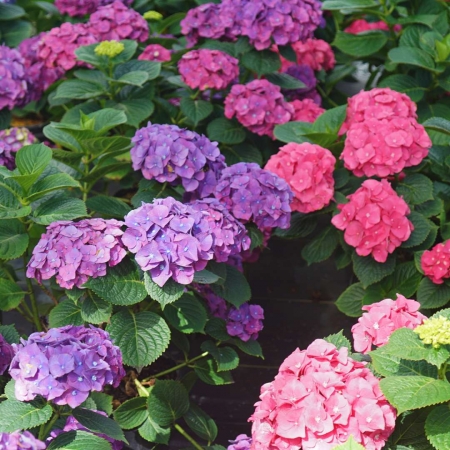Hydrangea macrophylla (Bigleaf Hydrangea)
×
Color Name: Let's Dance® Big Band®
It's the extra-large inflorescences that give Let's Dance Big Band hydrangea its name, but that's not the only feature that sets this selection apart. It combines bodaciously big mophead flowers with pure, true colors (pink in neutral/basic conditions, blue in acidic conditions) on a plant that survives winter better and reblooms better. That means more flowers, from the beginning of hydrangea season until the snowflakes fly! Flowers may be bright pink or deep purple, depending on soil chemistry.
Growing Tips: Bigleaf hydrangeas benefit from a good layer of shredded bark mulch and afternoon shade, particularly in hotter climates. Apply a granular fertilizer formulated for flowering shrubs (like a rose fertilizer) if leaves start to yellow.
Soil: Moist but well drained soils are best. Bigleaf hydrangeas may wilt in dry soils but also cannot take soggy conditions for any period of time. Tolerant of a range of soil pH levels, however, soil pH will influence flower color.
Pruning: Avoid pruning bigleaf hydrangeas, except to remove any dead wood. These hydrangeas cannot be cut back or trimmed at any time of the year without impacting the bloom for either the current season or the next.
Uses: Bigleaf hydrangeas are classic choices for flower gardens, cottage gardens, and seaside plantings. They also make a showy addition to foundation plantings and can be used for low hedges or edging.
Photo courtesy of Spring Meadow Nursery, Inc.
It's the extra-large inflorescences that give Let's Dance Big Band hydrangea its name, but that's not the only feature that sets this selection apart. It combines bodaciously big mophead flowers with pure, true colors (pink in neutral/basic conditions, blue in acidic conditions) on a plant that survives winter better and reblooms better. That means more flowers, from the beginning of hydrangea season until the snowflakes fly! Flowers may be bright pink or deep purple, depending on soil chemistry.
Growing Tips: Bigleaf hydrangeas benefit from a good layer of shredded bark mulch and afternoon shade, particularly in hotter climates. Apply a granular fertilizer formulated for flowering shrubs (like a rose fertilizer) if leaves start to yellow.
Soil: Moist but well drained soils are best. Bigleaf hydrangeas may wilt in dry soils but also cannot take soggy conditions for any period of time. Tolerant of a range of soil pH levels, however, soil pH will influence flower color.
Pruning: Avoid pruning bigleaf hydrangeas, except to remove any dead wood. These hydrangeas cannot be cut back or trimmed at any time of the year without impacting the bloom for either the current season or the next.
Uses: Bigleaf hydrangeas are classic choices for flower gardens, cottage gardens, and seaside plantings. They also make a showy addition to foundation plantings and can be used for low hedges or edging.
Photo courtesy of Spring Meadow Nursery, Inc.
|
Flower Color: Pink/Purple Shades Foliage Color: Green Shades
Height: 2 to 3 Feet Spread: 2 to 3 Feet Hardy in Zone: 5, 6, 7 |
Blooms: Summer to Fall
Foliage Season: All Season |
Growth Rate |
Medium
|
Attributes |
Extended Bloomer Dried Flower Cut Flower or Foilage Specimen Plant Landscapes Mass Planting Rebloomer Easy to Grow Border
|






